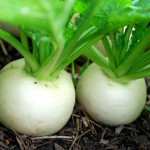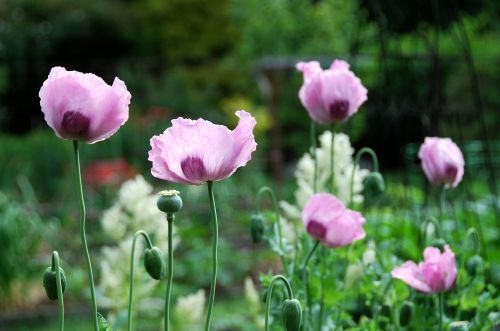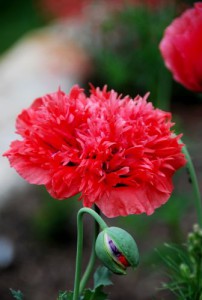Honestly, April and May ZOOM by me every year. There are so many spring garden events, seminars, plant sales, and tours – and of course the annual trek to Big Bloomer Flower Farm in Sanford, NC. (Check my website for a calendar of local NC Triad gardening events: https://learntogarden.anventure.com/ellen-blog/garden-events/)
But I cannot wait to get out to my own garden! Every day there are new plants peeking their first leaves out of the ground. Every day new blooms appear that I have not seen for a year. This year I added a totally new garden. Yes, I know that last year I said I was “done” with new projects, but there are no 12-step programs for gardeners!

Zen Garden in April
My family & non-gardening friends don’t really get this gardening thing. “What is it that you do out there all day long?” I am constantly making lists, so I thought I would share what I have been up to. Here is MY 12 Step Program! Maybe it will remind you of things to do in your own garden.

Hakurei Turnips
- Picking those spring veggies! We have eaten well this spring with loads of asparagus, spinach, fresh turnips (fabulous eaten raw), bok choy (delicious in chicken soup) and endive. I harvested onions today plus a few heads of garlic. We are still enjoying the last of the lettuce that has now started to bolt.

Spring Vegetable Garden
- Cleaning up after the spring vegetables made way for a May 1st planting of tomatoes, cucumbers, squash, pole beans, eggplant and burgundy okra – and two NEW vegetables this year! (1) Yacon, the root of which is harvested in fall and purported to be deliciously sweet eaten raw in salads and incredibly good for you. Read more here: http://www.motherearthnews.com/organic-gardening/yacon-root-zmaz06jjzraw.aspx (2) And Mexican sour gherkin – huge yields of small cucumber-like fruit that look like tiny watermelons. Picked when they are only an inch long, they taste like cucumber with a touch of lemon. I imagine crunching on these as a perfectly refreshing snack when I am hot and sweaty in the garden.

Purple Poppies
- I am now collecting seeds from spring blooming columbine, woodland phlox, hellebores, and euphorbia to sow or save as needed. Larkspur, poppies and blupleurum seeded last fall are in full bloom. Seed for zinnias, marigolds, celosia and cleome, amaranth and ornamental peppers have already sprouted in the garden, promising a summer of rainbow colors.
- Pruning again! Azaleas, snowball viburnums, spirea, roses, dogwoods, peonies, iris, and many other spring blooming trees, shrubs and perennials can be pruned right after their spring blooms have faded. Dead branches in your hydrangeas, blueberries & fig trees should be cleaned up now as well as daffodil & tulip foliage.
- Planting! I pulled out the dead dwarf butterfly bushes (The 2nd planting in two years lost due to the cold winter!) and replaced them with very reliable boxwoods in the part-shade behind my elephant. New plantings of ornamentals have been followed by a dusting of granular pre-emergent and 2” of mulch to control weeds. Here are more handy tips on weed control: http://www.thegardenersworkshop.com/winning-the-war-on-weeds/
- Of course there has been regular spraying of deer repellent. Every new leaf needs a shot of fragrant spray to keep it from being devoured.
- Planted summer annuals in containers and in the garden to fill spaces left from spring blooming bulbs & perennials.
- Divided perennials! (The soon-to-open Wesley Long Healing Garden in Greensboro now has my purple Iris & Tartarian Asters, as well as other pass-along plants from generous gardeners.)

Yellow Iris & Peonies at Entrance to Cutting Garden
- The crevices in the rock walls of my flower beds are favorite places for wasps to build nests. Wasps have proven their value in the garden by totally clearing my potato plants of fat brown potato bugs! Nevertheless, after repeated stings, and my screams, swelling and itching that followed, I figured out that a pre-emptive spraying of the wall in spring discouraged the wasps from nesting there in the first place. This is a far better solution than destroying the nest later.
- Another spring task was “pre-emptive” pruning of tall perennials that tend to fall over from their own weight. Asters are particularly bad about growing lanky and falling flat. Cutting them to half their size in April/May will help them stand up and grow fuller. They have plenty of time to put on new growth before they bloom in fall. This technique is also very effective with tall phlox, sedum, ironweed and goldenrod.

Red double Poppy
- Now that our trees are fully leafed out, it is a good time to take a hard look at the amount of shade in your garden. Do your flowering shrubs and perennials still bloom? Remember photosynthesis? Plants make energy from sunlight! Too much shade and they will not have the energy to bloom. Love your trees? Limbing them up can be a good compromise to bring in lots more light.
- Results of my soil test (Free in NC from April to November) showed that some areas of my garden had nutritional deficiencies. The best thing about a soil test is that I do not waste time and money trying to “fix” a problem that I haven’t diagnosed. Guessing at a solution can make things even worse! I have totally given up on chemical fertilizers. I have found that organic solutions make my plants much happier. The soil test always gives a recommendation for nitrogen fertilizer (they don’t even test for this!) The more organic matter (compost, manure) that you have in your soil, the less nitrogen you will need. Some organic sources of nitrogen include bloodmeal, feathermeal, cottonseed meal, alfalfa meal, chicken manure and organic fertilizer combinations such as the Epoma brand of fertilizers. Almost everything will grow better if your get your soil to a neutral pH, around 6.25-6.5.
Wishing you much joy in your garden.
Addicted and Happy,
Ellen
I love reading your articles! I am learning so much from this course, and am working harder in my own yard than I ever have before. The guidance and inspiration that come from you and the other great gardeners that you’re introducing us to is priceless! Thank you so much!